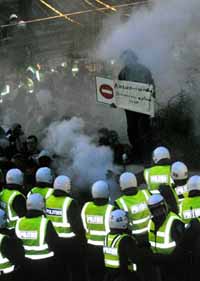Estonia removes disputed Soviet war memorial, 1 person killed in clashes
Estonian authorities removed the disputed Soviet war memorial overnight Friday, despite angry protests that triggered street clashes in which one person died and dozens were injured, the government said.

Click here to see the photo report
A man was stabbed to death and 12 police officers and 44 protesters were injured in the worst violence the Baltic country has seen since regaining independence from the Soviet Union in 1991, government spokesman Martin Jasko said. Some 300 people were detained.
The clashes started late Thursday after a day of mostly peaceful protests against the government's plans to move the Bronze Soldier statue and exhume the remains of Soviet soldiers buried nearby.
Estonia's ethnic Russians - roughly one-third of the country's 1.3 million population - see the monument as a tribute to Red Army soldiers who died fighting Nazi Germany, and vowed to protect it.
Many ethnic Estonians, however, consider the memorial a painful reminder of the hardships they endured under Soviet rule, and wanted it removed from the city center.
The government had started preparing the excavations Thursday by setting up a white pavilion around the monument to shield it from the public. A crisis management committee decided later Thursday to go ahead with the removal of the statue because of the tense situation, the government said in a statement.
It said excavations of the bodies had not yet started.
The government said the 2-meter (6-foot) statue would eventually be relocated to the Defense Forces cemetery. It is currently being held at an undisclosed location.
The dispute over the monument has aggravated tensions between Estonia and Russia, which had repeatedly called on its small neighbor to halt plans to move the memorial.
In Moscow, Russian Foreign Ministry spokesman Mikhail Kamyinin said the action "should be examined with all seriousness by international organizations and the necessary steps should be taken to cool the ardor of the Estonian authorities," RIA-Novosti news agency reported.
The Tallinn police department had braced for violence as preparation began to move the memorial, bringing in reinforcements from across the country.
Some 1,500 protesters rallied peacefully for hours, until a small group tried to break through a police line protecting the monument. In the violence that followed, angry demonstrators smashed windows and hurled rocks and bottles at police who tried to disperse the crowds with stun grenades. A bus shelter was set on fire as the clashes were followed by vandalism and looting.
One person was stabbed to death in the violence, the Interior Ministry said.
Soviet troops invaded the Baltic countries - Estonia, Latvia and Lithuania - in 1940, but were pushed out by the Nazis a year later. The Red Army retook them in 1944 and occupied them until the collapse of the Soviet Union in the early 1990s.
Subscribe to Pravda.Ru Telegram channel, Facebook, RSS!


